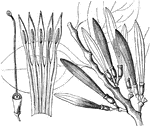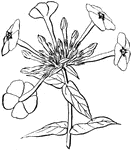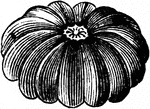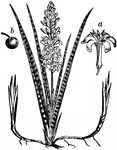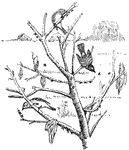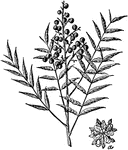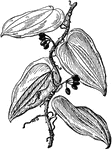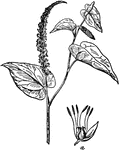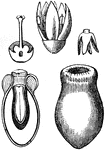
Struthanthus
"Details of the fructification of Struthanthus. 1. flower magnified; 2. section of calyx, ovary, and…

Mottled Dutchman's Pipe
"Aristolochia galeata. 1. fruit of an Aristolochia; 2. cross section of it; 3. half its seed." -Lindley,…

Bragantia
"Bragantia Blumei. 1. a section of its wood; 2. one of its flowers; 3. a seed; 4. the same divided perpendicularly;…

Danaea
"Danaea alata. 1. Collection of spore-cases; 2. sections of the same and spores, 2 of which are highly…
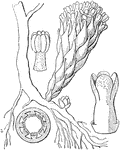
Cytinus
"Cytinus Hypocistis. 1. A flower; 2. a head of anthers; 3. a transverse section of the ovary." -Lindley,…

Centrolepis
"Centrolepis fascicularis. 1. A head of flowers; 2. a single flower separated; 3. an ovary with the…

Potamogetonaceae
"Zannichellia palustris. 1. A flower; 2. a cluster of ripe ovaries; 3. an ovary opened to exhibit the…
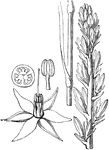
Mardja
"Haemodorum spicatum. 1. A flower spread open; 2. a cross section of the ovary; 3. an anther." -Lindley,…

Sauvagesia
"Lavradia Vellozii. 1. an expanded flower; 2. the stamens with exterior petaloid scales; 3. a seed;…

Turnera
"Turnera genistoides. 1. a flower cut open; 2. a section of the ovary; 3. a seed; 4. a section of it."…
Mangrove
Mangroves (generally) are trees and shrubs that grow in saline coastal habitats in the tropics and subtropics.…
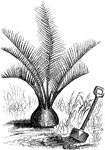
Arrowroot
Arrowroot, or obedience plant (Maranta arundinacea), is a large perennial herb of genus Maranta found…
Sisal Hemp
Sisal or sisal hemp is an agave Agave sisalana that yields a stiff fiber used in making rope. (The term…

Banana Plant
An illustration of a large banana plant. Banana is the common name for a fruit and also the herbaceous…
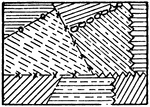
Cultivated Fields in General
The typical representation of cultivated fields in general on a topographical map.

Toothbrush Tree
"Branch with flowers of Salvadora persica. (a), a female flower; (b), the fruit." -Whitney, 1911
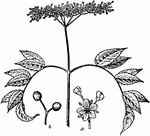
American Elderberry
"Branch with Inflorescence of Elder (Sambucus Canadensis). (a), part of the inflorescence; (b), fruits."…

Rock Samphire
"Upper part of stem with the inflorescence of Samphire (Crithmum maritimum). (a), a flower; (b), the…
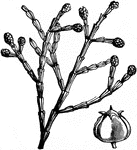
Sandarac Tree
Callitris quadrivalvis (or Tetraclinis articulata) is a coniferous tree in the cypress family known…

Indian Sandalwood
Santalum album is a small tropical tree cultivated for its fragrant oil and medicinal uses.

Maryland Black Snakeroot
"Flowering plant of sanicle (Sanicula marilandica). (a), a male flower; (b), the fruit." -Whitney, 1911

Aphid
Aphids, also known as plant lice, are small plant-eating insects, and members of the superfamily Aphidoidea.…
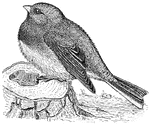
Junco
The Juncos, genus Junco, are small American sparrows. Their systematics are still very confusing after…
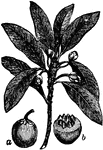
Sapodilla
"Sapodilla (Sapota zapotilla). (a), the fruit; (b), the same, transversely cut." -Whitney, 1911

Greasewood
"Greasewood (Sarcobatus vermiculatus). 1, with female flowers; 2, branch with fruits; a, a female flower;…

Mock Strawberry
The stem of the mock strawberry (Duchesnea indica), a flowering plant that gets its name from its fruit's…

Sassafras
"Sassafras (Sassafras sassafras). 1. Branch with fruits. 2. Branch with sterile flowers. a, b, c, different…

Summer Savory
The Summer Savory (Satureja hortensis) is a flowering plant of the Lamiaceae family. The image shows…
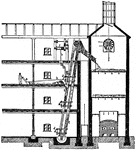
Malt House
An illustration of a floor malt house with a power shovel and bucket elevator for the green malt.

Early Saxifrage
"Flowering plant of saxifrage (Saxifraga virginiensis). a, a flower; b, the fruit." -Whitney, 1911

Scaled Leaves
A variety of leaves with scales: "a, the scale-like leaves of the stem of Lathraea squamaria (toothwort);…
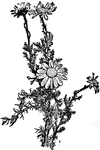
Chamomile
The name Chamomile or Camomile means "earth-apple", because of the applelike scent of the plant. It…
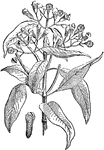
Clove Plant and Seed
Cloves (Syzygium aromaticum, syn. Eugenia aromaticum or Eugenia caryophyllata) are the aromatic dried…
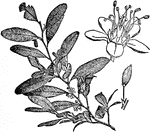
Coca Flower
Coca is a plant in the family Erythroxylaceae, native to north-western South America. The plant plays…
Coca Fruit
Coca is a plant in the family Erythroxylaceae, native to north-western South America. The plant plays…

Anamirta cocculus
An illustration of an anamirta cocculus leaf. Anamirta cocculus is an Southeast Asian and Indian climbing…

Anamirta cocculus Flowers
An illustration of an anamirta cocculus branch with flowers. Anamirta cocculus is an Southeast Asian…
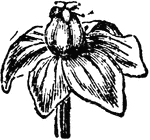
Anamirta cocculus Flower (Female)
An illustration of an anamirta cocculus female flower. Anamirta cocculus is an Southeast Asian and Indian…

Anamirta cocculus Flower (Female)
An illustration of an anamirta cocculus fruit. Anamirta cocculus is an Southeast Asian and Indian climbing…
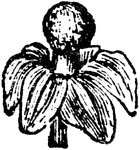
Anamirta cocculus Flower (Male)
An illustration of an anamirta cocculus male flower. Anamirta cocculus is an Southeast Asian and Indian…
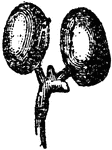
Anamirta cocculus Fruit
An illustration of an anamirta cocculus male flower with the sephals removed. Anamirta cocculus is an…
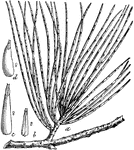
Pine Needle Scale
"a, Scales of Chionaspis pinifoliae upon pine-leaves, natural size; b, scale of male, enlarged; c, straight…
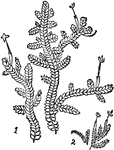
Liverworts
"Scale-mosses. 1, Ptilidium ciliare (fringewort); 2, Lophocolea minor (liverwort)." -Whitney, 1911
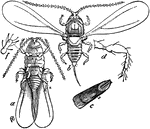
Scale Insect
"Scale-insect. Oyster-shell bark-louse of the apple (Mytilaspis pomorum); male. a, ventral view with…

Scammony
The scammony (Convolvulus scammonia) is a flowering plant of the bindweed family. R, the root.
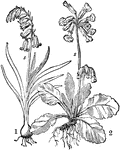
Scapes
A scape is a flowering, leafless stem; shown here on two different plants. "1. Wild hyacinth (Scilla…
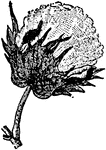
Cotton
An illustration of a ripe cotton capsule after dehiscence. Dehiscence is the spontaneous opening at…
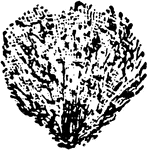
Cotton Seed
An illustration of a cotton seed. Cotton is a soft, staple fiber that grows around the seeds of the…
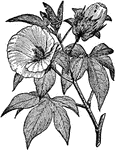
Cotton Plant
An illustration of a cotton plant. Cotton is a soft, staple fiber that grows around the seeds of the…
